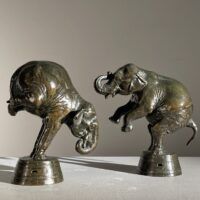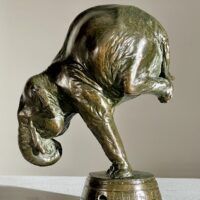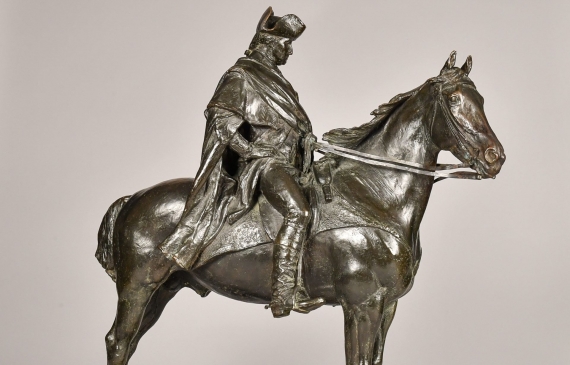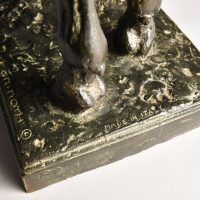












F. G. R. Roth (American, 1872-1944)
Performing Elephants, 1902
Bronze, dark brown patina
Hind legs: 6 ¼ H. x 6 W. x 2 ⅝ D. inches
Signature on base: Copyright 1902 by F.G.R. ROTH
Inscribed on base: ROMAN BRONZE WORKS N.Y.
Numbered underneath base: 12.
Front legs: 6 ⅛ H. x 4 ¾ W. x 3 D. inches
Signature on base: Copyright 902 F.G.R. ROTH
Inscribed on base: ROMAN BRONZE WORKS N.Y.







F. G. R. Roth (American, 1872-1944)
Gen. George Washington at Valley Forge, 1928
Bronze, dark brown patina
24 ¼ H. x 24 W. x 9 D. inches
signed on base: F.G.R. Roth
Inscribed on base: Fond. G. Vignali e C. Firenze
Made in Italy
General George Washington Encamped in Morristown, New Jersey, is a reduction of the monumental equestrian bronze in the center of Morristown. It sits on the triangle at the junction of Morris Street and Washington Avenue facing Washington’s headquarters. During two critical winters of the Revolutionary War, 1777 and again in 1779–80, the American Continental Army encamped in Morristown. Also there the Ford Mansion served as the headquarters to its commander-in-chief, General George Washington. Washington sits upon his horse wearing a winter uniform, a replica of the attire he would have worn during this cold New England winter. The conditions were grim, and Washington was said to have kept a lonesome vigil on his horse. During this time, the end result of the Revolution was in question, supplies were low for his soldiers, and the number in the army dwindled. His concern for the privation of his soldiers, lead him to pledge his own funds to pay them, an exampled followed by some of his officers. He attempted to grow and improve his army while in Morristown, and the loyalty of the soldiers never waned.
The front of the large statue simply reads, “Washington” and on the back the following words are carved:
“Headquarters at Morristown
January – May 1777
December 1779 – June 1780”
The statue was unveiled and dedicated by the lifting of two flags on October 19, 1928. This date is significant because on October 19, 1781, British General Cornwallis surrendered to Washington at Yorktown.
Frederick George Richard Roth was a leading American animal sculptor in the early 20th century. Born in Brooklyn, New York in 1872 he received his training at the Academy of Fine Arts in Vienna under Meyerheim, and in Berlin under Edmund von Hellmer. Roth also attended veterinary school, where he gained intimate knowledge of animal anatomies. He is very well known for his life-sized bronze sculpture of the famous Siberian husky, Balto, 1925. Balto was the lead of the dog sled that delivered the diphtheria serum from Anchorage to Nome Alaska, an event commemorated annually by the Iditarod. The bronze is in New York City’s Central Park, and it won him the National Academy of Design’s Speyer Prize. He is also renowned for his numerous sculptures and bas reliefs at the Central Park Zoo.
Throughout his life Roth was always an active member of the art community. He was a member of the Associate National Academy of Design, the New York Architectural League, the National Institute Art League, the Society of American Artists, the National Sculpture Society, the New Society of Artists, and the Society of Animal Painters and Sculptors. Today his work can be found in collections through the United States including: the Metropolitan Museum of Art, New York; the Detroit Institute of Arts; the Cincinnati Museum; the Children’s Museum, Boston; the San Francisco Museum; Museum, Newark; and Equestrian Washington, Morristown, NJ.